Click on images to enlarge
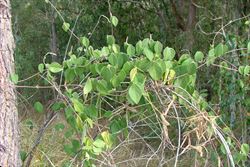
climbing habit (Photo: Sheldon Navie)
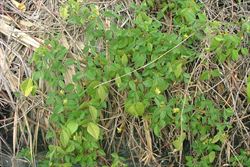
scrambling habit (Photo: Sheldon Navie)
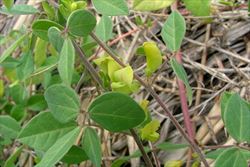
leaves and flowers (Photo: Sheldon Navie)
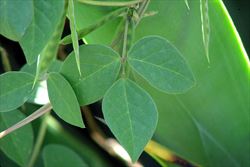
close-up of leaf (Photo: Sheldon Navie)
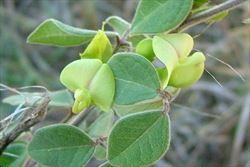
close-up of pale yellow pea-shaped flowers (Photo: Sheldon Navie)
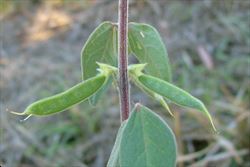
close-up of hairy stem and young fruit (Photo: Sheldon Navie)
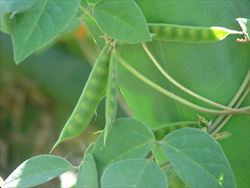
immature fruit (Photo: Sheldon Navie)
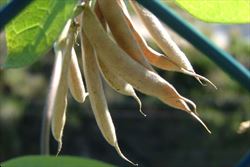
mature fruit (Photo: Sheldon Navie)

close-up of seeds (Photo: Tracey Slotta at USDA PLANTS Database)
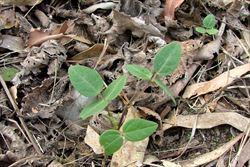
seedlings (Photo: Sheldon Navie)

shoot re-growing from long-lived rootstock (Photo: Sheldon Navie)
Scientific Name
Macrotyloma axillare (E. Mey.) Verdc. var. axillare
Synonyms
Dolichos axillaris E. Mey.
Family
Fabaceae (Queensland, the ACT, Victoria, Tasmania, and the Northern Territory)Fabaceae: sub-family Faboideae (New South Wales)Leguminosae (South Australia)Papilionaceae (Western Australia)
Common Names
Archer axillaris, axillaris, lime-yellow pea, perennial horse gram, perennial horsegram
Origin
Native to large parts of Africa (i.e. Kenya, Tanzania, Uganda, Burundi, Cameroon, Rwanda, Zaire, Ghana, Guinea, Nigeria, Sierra Leone, Togo, Angola, Malawi, Mozambique, Zambia, Zimbabwe, Botswana, Namibia, South Africa and Swaziland) and the Arabian Peninsula (i.e. Yemen).
Cultivation
Perennial horse gram (Macrotyloma axillare var. axillare) has been widely cultivated as a pasture legume in the warmer parts of Australia, particularly in northern New South Wales and southern Queensland. The cultivar 'Archer' is the only variety sold commercially in Australia for this purpose.
Naturalised Distribution
Widely naturalised in south-eastern and northern Queensland, and occasionally naturalised in central Queensland.
Habitat
This species prefers fertile soils in tropical and sub-tropical regions. It is a weed of roadsides, fences, disturbed sites, open woodlands, grasslands, highland pastures, parks and gardens.
Habit
A trailing or climbing vine with stems usually growing up to 3.5 m long (occasionally up to 10 m in height), that are produced from a long-lived (i.e. perennial) woody rootstock.
Distinguishing Features
- a long-lived trailing or climbing vine with stems covered in close-lying hairs.
- its compound leaves have three leaflets that are hairy on both surfaces.
-
its greenish-yellow pea-shaped flowers are arranged in small clusters in the leaf forks.
-
its elongated pods (3-5 cm long and about 7 mm wide) are hairy and have a pointed tip.
Stems and Leaves
The rounded stems are covered with close-lying hairs (i.e. they are appressed pubescent).
The alternately arranged leaves are compound with three leaflets (i.e. they are trifoliate). On the stem near the base of each leaf there are two small elongated structures (i.e. stipules) that are 2-5 mm long and 1-2 mm wide. Each leaf is borne on a stalk (i.e. petiole) 8-45 mm long and the individual leaflets are oval (i.e. elliptic), egg-shaped in outline (i.e. ovate), or somewhat diamond-shaped (i.e. sub-rhomboidal). These leaflets (1-7 cm long and 0.5-4 cm wide) have rounded to somewhat pointed tips (i.e. obtuse to acute apices) and are about 1.5 times as long as they are broad. They are hairy (i.e. pubescent) on both surfaces, but are somewhat paler beneath, and have entire margins. The leaflets also have a distinct central vein with 5-6 lateral veins on each side.
Flowers and Fruit
The flowers are arranged in small clusters (usually containing 2-6 flowers) in the leaf forks (i.e. in few-flowered axillary racemes). They are greenish-yellow in colour (14-20 mm long) and borne on very short flower stalks (i.e. pedicels) 2-3 mm long. Each flower has five small sepals that are partially fused into a tube (i.e. calyx tube) 2-3 mm long, with pointed (i.e. acuminate) lobes that are a little longer than the tube (2-5 mm long). The larger, uppermost, petal of each flower (i.e. the standard) is oblong in shape (12-20 mm long and about 10 mm broad) with two narrow structures (i.e. linear appendages) about 5 mm long. The two side petals on each flower (i.e. the wing petals) are about 12 mm long, and are about the same size as the lowermost folded petal (i.e. the keel). The elongated ovary in the centre of the flower is covered with close-lying (i.e. appressed) white hairs and is topped with a stigma that is surrounded by a ring of short dense hairs.
The mature pods (i.e. legumes) are flattened, elongated in shape (3-8 cm long and 5-8 mm wide), and have a pointed tip (3-7 mm long). These fruit are covered in hairs (i.e. they are pubescent), turn from green to pale brown in colour as they mature, and contain 3-9 seeds. The seeds (3-4 mm long and 2-3 mm wide) are somewhat flattened (i.e. compressed) or almost egg-shaped (i.e. sub-ovoid). They are biege to reddish in colour, mottled with black, and have a small raised structure (i.e. hilum).
Reproduction and Dispersal
This species reproduces by seed and has been deliberately spread as a pasture legume. It is probably also dispersed as a contaminant of agricultural produce (e.g. fodder and pasture seeds).
Environmental Impact
Perennial horse gram (Macrotyloma axillare var. axillare) is regarded as an environmental weed in Queensland. This species has become a serious weed in open forests and woodlands, where it climbs on woody plants and affects the regeneration of native species. It is currently of most concern in south-eastern Queensland, where it is rapidly spreading and ranked among the top 200 most invasive plant species.
Perennial horse gram (Macrotyloma axillare var. axillare) appears on several local environmental weed lists in this region (e.g. in Redlands, Maroochy, Cooloola and Caboolture Shires) and is invading native vegetation near Mount Emu on the Sunshine Coast. This area includes the habitat of most remaining populations of the endangered Mount Emu she-oak (Allocasuarina emuina). Perennial horse gram (Macrotyloma axillare var. axillare) is also becoming a concern in central Queensland (e.g. in the Burnett Shire) and far northern Queensland, where it is listed as a priority weed species.
Legislation
Not declared or considered noxious by any state government authorities.
Similar Species
Perennial horse gram (Macrotyloma axillare var. axillare) is very similar to annual horse gram (Macrotyloma uniflorum). These two species can be distinguished by the following differences:
- perennial horse gram (Macrotyloma axillare var. axillare) is a large creeping or trailing plant with stems up to 3.5 m or more long. Its flowers are usually borne in small clusters (of 2-6 flowers) and the main vein on the two side leaflets of each leaf is almost central (i.e. its lateral leaflets are almost symmetric).
- annual horse gram (Macrotyloma uniflorum) is usually a smaller plant with semi-upright (i.e. sub-erect) or creeping stems less than a metre long. Its flowers are sometimes borne singly (usually in 2-3 flowered clusters) and the main vein on the two side leaflets of each leaf is not central (i.e. its lateral leaflets are asymmetric).
It is also relatively similar to several of the yellow-flowered native Vigna species, including dune bean (Vigna marina), maloga bean (Vigna lanceolata) and Dalrymple vigna (Vigna luteola). However, these species can be distinguished by their long flower stalks (i.e. peduncles).

